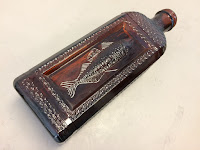My caption for the photo simply said "The Bratt – Oliver House on Van Dyke Road has undergone many architectural changes over the years. It is now part of the Spinney community and was once part of the Leonard Farm."
I am pleased to report that a member of the Leonard family, Brian Leonard of North Carolina, reached out to Our Towne with more photos and remembrances of growing up in this home on Van Dyke Road. I like Brian's way with words, and with his permission, here's his whole letter. Enjoy!
 |
| Circa 1940 |
Dear John and Marjorie,
A couple of weeks before today, Thanksgiving 2017, I was
visiting with my dad, Richard Leonard, and he shared a copy of the October 2017
issue of Our Towne that my aunt
Barbara had sent to him. What a pleasant surprise to see my childhood,
ancestral, home on the front cover.
As is usual for a couple of old men, that led us down a path
of reminiscing about the [Leonard] farm. Not that it makes me any more special
than anyone else in this world, but the thought of that farm, and how my
family’s history was so closely tied to it, always makes me feel like the I am
the luckiest man in the world.
Lucky me, I’m the last in line. Quite literally, arguably,
the last of my family to be born and raised at 246 Van Dyke Rd. While the farm only carried the name Leonard
for a brief time, beginning around 1920 when my great grandfather Ralph Irving
Leonard bought the farm from his sister in law and ending with the sale to the
owner’s of Spinney Preserve, it has been part of my larger family’s heritage
since the Van Rensselaers were the prominent landholders in the area.
The house, now called the Bradt-Oliver house, (both names
show up in the Leonard genealogy) was an absolutely idyllic place for a boy to
grow up, and even though I didn’t understand its personal historic
significance, I relished the fact that the house I was raised in wasn’t your
typical modern home. Add a little over one hundred acres to the scene and it
becomes obvious why that place is special.
 |
| Circa 1940 |
The old stone part of the house, the original house, caught
my great grandfather’s eye and he spent a long time turning it into his dream
home with his wife, Lillian Salisbury. Prior to buying the farm he had been a
carpenter for the NY Central RR and used those skills, and timber harvested
from the farm, to more than double the living space during the 1950’s and early
1960’s. I have heard a few rumors over the years that there are stories of an
even older cabin having been on, or near, the house site but no one that I’m
aware of has presented any real evidence.
The original part of the house was, as you noted, built some
time before 1768, and was a fairly typical pre-colonial Dutch influenced home. A
simple rectangle with stone walls almost 2 feet thick chinked with a
combination of mud and horse hair. It was built as a single living level split
into two rooms, with a haymow above and a cold cellar below. The floors are all hand hewn tongue and
groove with beams that measure better than a foot across. One of my favorite
things about “the front room” (our term for the old house) were the twelve over
twelve windows. I’ve visited the house a few times over the years since moving
away and am sad to see those windows have been replaced. To my own discredit,
however, I personally may have had a little to do with that, having broken and
repaired several panes during childhood activities.
I don’t recall the details but I do recall seeing names and
dates here and there on the old woodwork. Though I’ll add the most notable date
to me, 1807, was carefully carved in a beam of “the big barn” that once stood
on the other side of Van Dyke Rd.
I don’t think I’m alone in feeling that, as youngsters, we
all tend to be too busy growing up to notice, or care about, these things. But
as I’ve aged I’ve come to see that is something almost all of us look for. Our
place. Where we are, where we’re going, where we came from, who our people
are. And that is one of a myriad of
reasons why I feel so lucky. Last in line or not, I was given a rare chance to
grow up steeped, literally, in my peoples history.
I could go on and on, boring you with stories of life at
that end of Van Dyke Rd. Such as how songbirds nesting in the stone walls
surrounding my bedroom would wake me, literally, every day an hour before
sunrise, or snowshoeing the snow covered fields on a pair of bear paws that
“are older than I am” according to my dad. Plus other rites of passage, like
the sunny summer morning of my seventh year when my grandfather, Irving Ralph,
stuck me on the Ford 8n his father bought new in 1947 and taught me to drive.
And for you romantics things like first kisses in the barn’s haymows. But I
digress.
I will close with this thought. I believe we honor our
ancestors, near and far, by remembering them. Thank you for taking your time
and remembering some of mine.
Brian Leonard
 |
| Circa 1988 |



















































